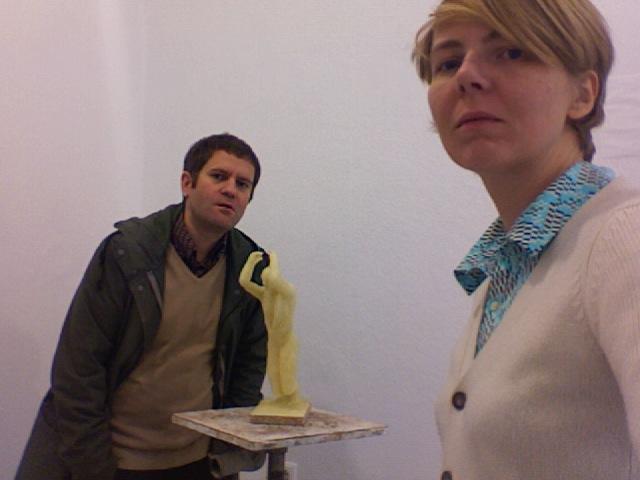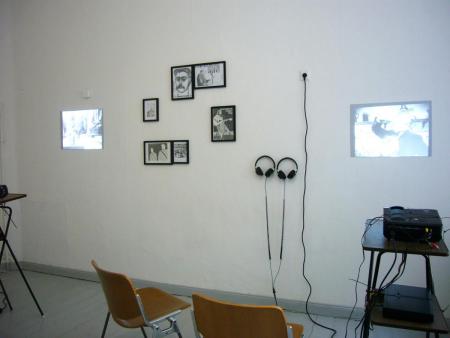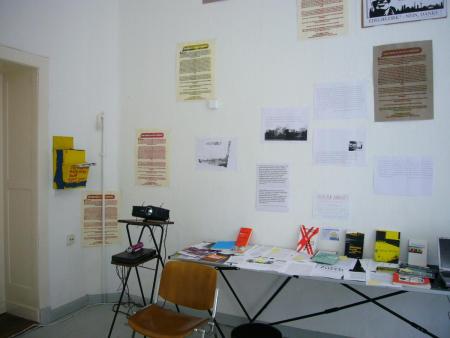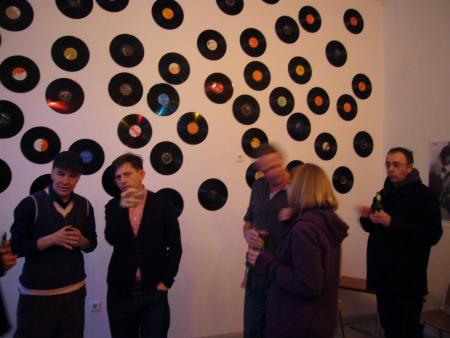Have you met...Diego Castro and Eva May
Have you met...Diego Castro and Eva May

Diego Castro and Eva May are preparing for the upcoming exhibition of Franziska Wildt’s work in their space Gitte Bohr: Galerie für Kunst und politisches Denken opening this Thursday, the 10th of November at 7pm. They took some time out of their busy schedules to answer some questions about their space and pose for a photo with a sculpture by Wildt, providing us with a sneak peek of their next show.
First, it would be great if you could tell me a bit about yourselves.
We are of Danish, German and Spanish decent and our backgrounds are visual art, anthropology and cultural theory. We have been employed by large art institutions, commercial galleries and art academies and have lived in London, Geneva, Frankfurt, Copenhagen, before settling in Berlin about 1 year ago. In short, we are highly educated people in precarious economic situations.
And now a bit about the space, when and where did it begin?
Gitte Bohr was born in December 2010 in Neukölln.
What was the main concept of the project?
Gitte Bohr is a non-commercial space for art and political thought, as the name says. Through solo- and group exhibitions, film screenings, talks, and info-shows we are creating a place where the focus is on positions, which examine immediate political and social questions, or, which relate to the historical avant-garde art’s positioning as being opposed to consensual bourgeois culture.

"Memories of Heidelberg. Kriegsblind und Friedenstaub" with Diego Castro at Gitte Bohr
What was your inspiration for the projects? Are there any historical precedents that you find relevant?
Gitte Bohr was established as a response to the experience that in Berlin there are hundreds of art spaces, but hardly any that programmatically present critique. The art-market in Berlin is hardly more than a phantom. Still the mythology of a functioning market in a city with almost no collectors and only little sales on the local marketplace keep haunting the heads of many young artists and curators. As a result there seems to be a general phobia towards connecting art-practice and life-praxis. We didn't want to work for the rat race, but rather found it necessary to combine a high standard of quality with an autonomous positioning, considering the role of art in society. So, we decided to nail our colours to the mast and do our own thing.
Why did you choose this name?
“Gitte Bohr” is a name with many facets. It’s a pun on Guy Debord, the French Situationist. It’s the love child of Gitte Hænning and Niels Bohr. It’s a reference to the many large commercial galleries in Berlin run by Scandinavian women and Gitte is also a common name with Berlin's art-dealers.
“Gallery for art and political thought” is a description of what we do.

"Symbolic Capital" exhibition at Gitte Bohr
Do you have an example of a particular event or show that you think was particularily successful in defining the gallery's objectives?
So far our program has been developing mostly with sequential exhibitions. In the spring we had three shows in a row on the theme of images of war. It came from our wondering why there is such a marginal distribution of images of the current war in Afghanistan and if there’s a connection between this and the fact that no one seems to care about the war. We also examined in which way this war, like many others before is made by and in response to images. To our great astonishment, everyone who came to the exhibitions had an opinion about the question, and the fact of our offering a place and some provocation, made them utter it and think about it. The success consisted in the great conversations and great feedback we had.
How do you finance the project?
Self-exploitation, beer.
Do you have any favorite mainstream galleries in Berlin? In the world?
Mainstream is for wimps.

"Ciao Renate!" event at Gitte Bohr
How do you see the program developing in the future?
As a joint venture, Gitte Bohr is moving to a place known as "West Germany" at Kottbusser Tor in Kreuzberg. From February 2012 on, we'll have a much larger and more centrally located space. In the new framework, we will be able to break up the exhibition format limited by the small room. The focus will be more on events and collaborations, with a few exhibitions every year. Among others, we are planning a theatre and conference event on superficiality and an exhibition and publication that actualises “The Right to be Lazy” by Paul Lafargue.
Maybe you could also tell me a bit about what to expect/look forward to with the upcoming exhibition.
The upcoming exhibition opens on 10.11. It presents the emerging artist Franziska Wildt. She has worked on an artistic research project about a group of artists, former students of Berlin's art-school, who during the Third Reich were members of the resistance movement "Red Orchestra" (Rote Kapelle) and were arrested by the Gestapo and executed.